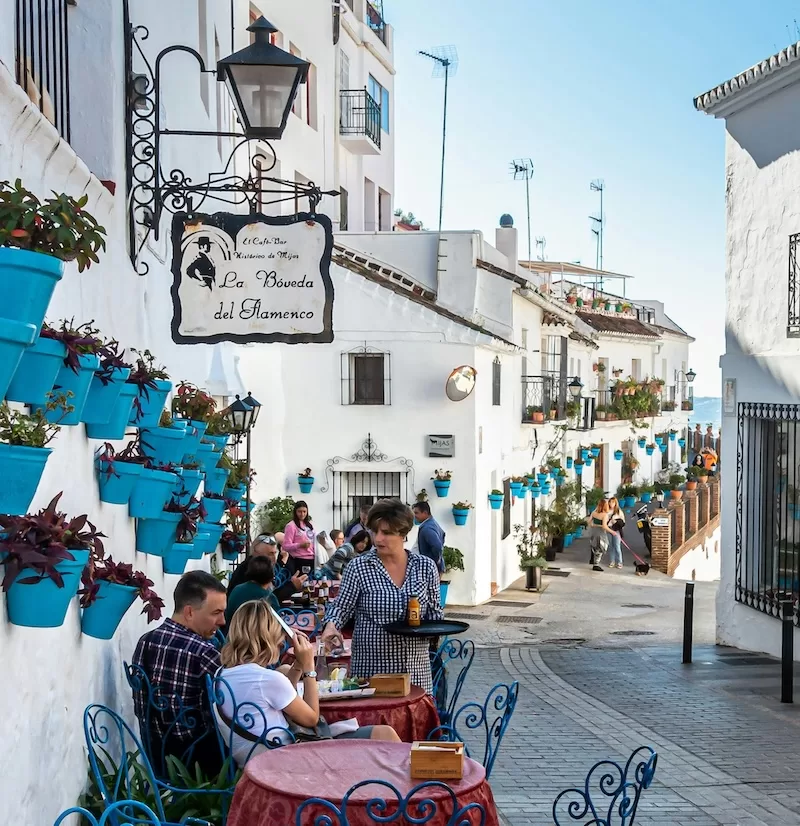Introduction
Deciding where your money goes further matters more than ever. When comparing the cost of living in Spain vs USA, the numbers reveal more than just price tags; they reflect different lifestyles, priorities, and trade-offs. If you’re weighing up a move, an extended stay or just curious how far your earnings stretch, this article walks through real data, practical examples and smart considerations. Expect a grounded, traveler-and-expat perspective that focuses on value without glamourizing or over-promising.
What the numbers tell us
Overall cost-of-living difference
On broad terms, the cost of living in Spain is substantially lower than in the United States, and the difference goes beyond just a few euros here and there. Sources reports that the average monthly expense for a single person in Spain sits around US$1,583, while in the United States it’s roughly US$2,516. That’s a ~40% gap, and when you zoom out, it tells a story of two very different economic rhythms.
In Spain, essentials like rent, groceries, and transport tend to eat up far less of your paycheck, giving many expats and remote workers breathing room they rarely find in major U.S. cities. A night out doesn’t feel like a financial decision, and even daily habits (a morning latte, fresh produce, an occasional tapas dinner) add up more gently.
Data from Numbeo backs this up: overall, the U.S. cost of living (including rent) is about 47% higher than Spain’s average. That means someone living in Madrid or Valencia can often maintain a comfortable lifestyle on nearly half of what it would cost in Los Angeles, Boston, or Miami. The pattern holds across most categories, suggesting that Spain’s affordability isn’t a niche expat illusion but a consistent, data-backed reality.
Housing and rent: major savings
Housing is where the difference between living in Spain and the United States really hits home — quite literally. Rent is the single biggest expense for most people, and it’s also where Spain delivers its most dramatic savings.
According to Numbeo, city-center apartments in the United States cost around 69% more than comparable units in Spain. Even outside city centers, the gap remains wide. An apartment that rents for US$1,200 in Madrid might easily run US$2,000 or more in Austin or Denver, and that’s before factoring in higher utilities, parking, or local taxes.
These aren’t isolated cases; they’re part of a broader trend. Expat and relocation data suggest that housing costs in Spain can be up to 45% lower overall compared to the U.S. average.
Part of the reason lies in Spain’s housing model. Apartments tend to be smaller, yes, but also built for efficiency: thick walls, natural light, and outdoor space designed for year-round living. Many come with community courtyards or shared pools, something that in the U.S. might only exist in high-end complexes.
It’s the difference between spending most of your income just to have a home versus having money left to enjoy it. In Spain, it’s far more common for locals and expats alike to rent comfortable spaces in desirable neighborhoods without stretching every paycheck. For anyone relocating, this is where the savings often begin and where they start to truly feel the lifestyle upgrade that lower living costs make possible.

Read More Like This: Best Places to Live in Spain: A City-by-City Guide for 2025
Food, groceries, and dining out
Food is one of the clearest (and most enjoyable) ways to feel the cost difference between Spain and the United States. Groceries in Spain are roughly 30%–35% cheaper than in the U.S., and meals out can cost up to 40% less on average. A casual lunch menu (the famous menú del día) might set you back €12–€15, often including two courses, bread, a drink, and dessert. In most American cities, that barely covers a sandwich and a coffee. Even fast food or delivery meals typically come in at lower prices across Spain’s major cities.
Other sources also reinforce this, showing grocery costs about 32% lower than in the U.S. for similar shopping baskets. Staples like olive oil, fresh vegetables, local bread, and wine are both cheaper and fresher, seasonal, and often sourced locally. From Barcelona’s La Boqueria to Madrid’s Mercado de San Miguel or Valencia’s Central Market, food shopping is a sensory experience. You’ll find pyramids of oranges and peppers, fresh seafood packed on ice, and stalls selling artisanal cheeses and cured meats sliced on the spot. Most vendors know their regulars by name, and prices are often negotiable. Even smaller towns have weekly open-air markets, where locals fill baskets with whatever’s in season: tomatoes that taste like summer, honey from nearby farms, or homemade olive tapenade. Farmers’ markets still anchor weekly routines, and eating “in season” isn’t a lifestyle choice; it’s just how people shop.
Dining out follows the same logic. A meal for two in a mid-range restaurant in Spain can cost around US$45, compared to US$80–$100 in the U.S. Add to that Spain’s modest tipping culture (around 5–10%) and the math becomes clear: good food, enjoyed often, at a fraction of the cost.

Utilities, transport, and other recurring costs
Recurring expenses are where small differences add up over time. Utilities in Spain (electricity, water, heating, and internet) average about US$188 per month, compared to roughly US$429 in the United States. Public transport also costs less: a monthly metro pass in Madrid averages around €54, while in New York it’s closer to US$132.
Expatistan data shows U.S. costs for categories like entertainment, personal care, and transportation can be 50–80% higher than in Spain. Even mobile plans and streaming services are slightly cheaper across Spain’s major cities.
In practical terms, these smaller differences create consistent monthly breathing space. You notice it not just in savings, but in reduced financial anxiety.

Healthcare and education costs
Healthcare is another area where Spain delivers immense value. Spain’s public system covers most essential medical needs with minimal or zero out-of-pocket costs for residents. Even private insurance is affordable: roughly €60–€100 per month, depending on coverage.
In the U.S., healthcare premiums can exceed US$500 per person monthly, and co-pays or deductibles often create unpredictable expenses. The same pattern holds in education — Spain’s public universities and childcare options remain accessible and heavily subsidized compared to American counterparts.
The outcome is simple: in Spain, you can plan your expenses. In the U.S., you often brace for them.
Why does the difference exist
Income, purchasing power, and salary gaps
It’s important to underline that Spain’s affordability doesn’t exist in a vacuum. The lower costs come hand in hand with lower average salaries, which means the equation changes depending on how and where your income originates. The average after-tax salary in Spain sits around €1,700 per month, compared to roughly US$4,300 in the United States. That gap can feel dramatic on paper, but the real story lies in how far each euro or dollar stretches.
In Spain, many essentials cost less not just because of lower wages, but because entire systems are built around moderation: healthcare is heavily subsidized, public transport is efficient and affordable, and social life doesn’t revolve around expensive entertainment or consumption. Locals often rent smaller apartments, rely on public spaces instead of private yards, and eat fresh, inexpensive food from neighborhood markets.
For someone earning a U.S. or international salary, the effect is magnified. Remote workers and retirees paid in dollars or pounds often find themselves living comfortably compared to locals on Spanish wages. But for those earning locally, the difference in purchasing power balances out: your costs are lower, but so is your paycheck.
The trade-off, then, is less about arithmetic and more about alignment. Spain offers value, stability, and quality of life, but not necessarily rapid wealth accumulation. You gain time, health, and balance, currencies that hold their own kind of worth.
Cultural and structural factors
Several structural elements help explain the gap:
- Spain’s housing market plays by a different set of rules. Outside high-demand zones like Madrid or Barcelona, prices tend to stay grounded. You don’t see the same wild fluctuations or bidding wars common in American metros such as Austin, San Francisco, or Miami. Spanish property markets are built around ownership stability rather than speculative growth, which keeps average rents and sale prices in check.
- It’s worth considering the European relationship to space. In many Spanish cities, “home” is compact, efficient, and designed to flow into public life: cafés, plazas, and parks are natural extensions of your living room. The American idea that bigger automatically means better (and therefore more expensive) doesn’t really apply. Smaller homes are the norm, not a downgrade, and that translates into lower heating bills, simpler maintenance, and less consumption overall.

- Public systems are another major factor. Spain’s healthcare, education, and even intercity transport are subsidized and reliable, reducing the need for high private spending. These services form part of what taxes pay for, so the average person doesn’t carry the same personal financial burden seen in the U.S., where private healthcare and college tuition can dominate family budgets.
- Lower tipping culture and fewer “hidden” costs compared to U.S. service expectations. A family report moving from California to Spain noted that “our money seems to go farther” due to lower out-of-pocket expenses.
Real-life example: a single person vs a family
To put the numbers into perspective, it helps to imagine two everyday scenarios: one for a single professional, and another for a family of four.
- Start with the single remote worker. In Spain, this person could comfortably cover rent, groceries, and utilities for around US$1,700 per month. That figure includes a city apartment, a modest food budget with plenty of meals out, and all regular bills. In the United States, the same lifestyle easily rises to US$2,500 or more, depending on the city, a difference large enough to change how much you save, travel, or even work.
- Now scale that up to a family of four. The same data shows their monthly budget averaging US$3,156 in Spain, compared to US$5,861 in the U.S.; nearly double for a comparable standard of living. The extra breathing room in Spain means less pressure to chase overtime or constantly rebalance expenses. Families often find they can live on one income, enjoy family meals out, and still afford weekend trips.
But context still matters. Living in central Madrid or Barcelona will tighten the margins, while mid-sized cities like Valencia or Málaga offer far more for the same budget. School choice, lifestyle preferences, and local taxes all shift the equation.
What stays constant, though, is the underlying difference in cost-to-comfort ratio. A single person finds room to breathe; a family finds time to share more meals together. That’s what “value” looks like when measured in real life instead of spreadsheets.
Read More Like This: Cost of Living in Spain: What to Expect in 2026
What to watch out for if you move
- Location matters big time: Cities like Madrid and Barcelona command higher rents and restaurant prices that mirror mid-tier American metros. The “Spain is cheaper” story holds truest in medium-sized or coastal cities (Valencia, Granada, Málaga) or in smaller towns where daily expenses remain consistently low. Choosing your base can be the difference between cutting your budget in half or barely trimming it.
- Earnings source: If your income is in euros and tied to the local economy, you’ll enjoy stability but won’t feel rich; salaries are lower, and wage growth is modest. Remote workers or retirees earning in U.S. dollars, Canadian dollars, or pounds, however, gain a built-in advantage. Currency exchange effectively boosts their purchasing power, letting them enjoy a higher standard of living at local prices.
- Taxation, residency, and legal costs: Spain’s tax structure can be complex for newcomers, particularly if you maintain income streams abroad. Understanding double taxation treaties and residency rules ahead of time saves headaches later.
- Inflation and cost trends: Spain hasn’t escaped the global rise in housing and energy costs. According to an AP News report, rents in major cities are climbing, and a broader housing shortage is taking shape. While still more affordable than the U.S., the gap isn’t static.
- Lifestyle expectations: Lower cost doesn’t always equal identical comfort. Homes are smaller, appliances compact, and imported goods pricier. But that’s also part of the trade: a culture built less around accumulation, more around experience. When you adapt to that vibe, “less” often starts to feel like exactly enough.
Summary of key takeaways
- The data around the cost of living in Spain vs USA points to a consistent truth: Spain delivers lower overall living costs across nearly every category, from rent to healthcare to daily essentials.
- Housing remains the biggest differentiator. The price gap between Spanish and American rent can define your entire budget, often freeing up hundreds or even thousands per month.
- Every day costs stack in Spain’s favor. Groceries, utilities, transport, and medical care all come in noticeably cheaper, making comfort and leisure more accessible to the average household.

- Income levels shift the equation. Lower wages in Spain can offset some of the savings, but anyone earning or retiring on a foreign income will feel a major purchasing power boost.
- Strategy makes the difference. Where you live, how you earn, and what kind of lifestyle you want determine how much value you capture. Choosing well can turn “affordable” into genuinely life-changing.
FAQs
Q1: Is it always cheaper to live in Spain than in the U.S.?
Generally, yes, though how much cheaper depends on where you live and how you spend. Big U.S. cities like San Francisco or New York can be 70–90% more expensive than mid-sized Spanish ones like Valencia or Granada. In contrast, living in rural America versus central Madrid narrows the difference.
Q2: Does lower cost mean lower quality of life in Spain?
Not at all. Spain’s affordability often translates to less financial pressure and more time. Public healthcare and transport systems are efficient, fresh food is accessible, and social life revolves aroundthe community rather than consumption. The quality gap often tilts in Spain’s favor, just with smaller living spaces and fewer material extras.

Q3: Will earning in U.S. dollars while living in Spain create an advantage?
Yes, if income is in USD or other high-value currency and expenses are in euros, you may realize significantly greater buying power, but currency risk applies.
Q4: Will moving my family to Spain cut our costs in half?
In many cases, yes. Data suggests families of four may spend around US$3,500/month in Spain compared to US$5,800 in the U.S. Housing, healthcare, and childcare drive most of that gap. The key variable is city choice: a family in Málaga saves more than one in Barcelona.
Q5: Which categories show the biggest and smallest differences?
The biggest savings come from rent (up to 60–70% lower) and healthcare (up to 80% lower). Moderate savings appear in groceries and dining out (30–40%). The smallest gaps are in electronics, fuel, and imported goods, which are often similarly priced or higher in Spain due to taxes.
Q6: Are taxes higher in Spain than in the U.S.?
Yes, marginally, but Spanish taxes often replace private costs like healthcare and schooling. What you lose in net income, you often gain in reduced personal expenses and social coverage.
Q7: How does transportation compare?
Public transport is where Spain shines. A metro pass in Madrid costs around €54 per month, compared to US$132 in New York City. Fuel, however, is pricier in Spain (roughly €1.60 per liter versus around US$1.00 in the U.S.), though fewer people rely on cars daily.
Q8: Is Spain’s inflation keeping pace with the U.S.?
Spain has experienced moderate inflation, particularly in housing and energy, but it still trails the U.S. in overall cost increases. The country’s inflation rate averaged around 3.1% in 2024, compared to 3.4% in the U.S., keeping its value edge intact.
Q9: What about digital nomads — how easy is it to sustain a U.S.-level lifestyle?
Spain’s new digital nomad visa makes it especially appealing. Earning in a strong currency lets remote workers enjoy high living standards on modest budgets, often renting premium apartments or traveling regularly while spending less than half what they would in the States.
Q10: Is it realistic to retire in Spain on a U.S. pension?
Yes. Many retirees find they can live comfortably on US$2,000–$2,500 per month, especially outside major cities. Lower rent, healthcare, and food costs make Spain one of the most sustainable retirement options for Americans in Europe.
Living Well for Less Isn’t a Myth. It’s Spain.
After breaking down the cost of living in Spain vs USA, the numbers tell a clear story. Spain offers not only lower prices, but a different life, one where time, food, and community hold more weight than square footage or spending power. The value shows up everywhere: rent that doesn’t consume your paycheck, groceries that are fresh and affordable, and healthcare that doesn’t leave you anxious about a bill.
For travelers, expats, or remote professionals, the opportunity is tangible, but it isn’t automatic. The advantage depends on making smart, informed moves: choose your location strategically, align your income source with your cost base, and adjust expectations toward a lifestyle built around experience, not excess.
Spain rewards those who plan, not those who guess. Subscribe to our newsletter for more data-driven insights and relocation guides that turn curiosity into confident decisions.










